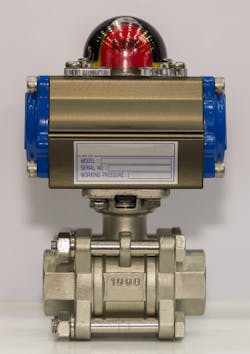Understanding the advantages of double-acting actuators
Actuators convert process signals into mechanical motion, causing valves to open or close, thereby controlling the flow of fluids. These devices are available in different designs and sizes to aid the automation of diverse piping systems. Actuators enhance the accuracy and precision of processes since they guarantee the smooth operation of valves irrespective of the cycling requirements. When selecting valves for particular applications, it is imperative to consider their actuation methods. Popular valve actuators for industrial piping systems include electric, pneumatic, and hydraulic actuators.
This article is part of our monthly Tactics and Practices column. Read more Tactics and Practices.
Pneumatic and hydraulic actuators rely on the pressure of air or fluid to manipulate the position of a valve. Both categories of actuators are either spring return or double-acting. Spring return actuators are single-acting. Therefore, any section mentioning single-acting actuators in this article will be referring to spring return actuators. How does the design of these actuators affect their efficiencies?
A spring return actuator has a spring on one side of the piston to keep the valve in its desired position. Such actuators can either have normally closed or normally open configurations. In a normally closed orientation, frequently referred to as fail-closed, the force from the pressurized air or oil (for hydraulic) is supplied from the unloaded side of the piston. The force from the pressurized fluid overcomes the spring force, compressing it to open the valve. Withdrawing the supply of the pressurized fluids causes the spring to retract and return the valve to its closed position. The inverse configuration of this setup keeps the valve at a normally open setting. Supplying pressurized fluid closes the valve, while withdrawing fluid pressure causes the spring to open the valve.
Figure 1. The high thrust strength capabilities and small sizes of double-acting actuators make them preferable for highly demanding industrial pipelines.
In contrast, a double-acting actuator contains two compartments for holding pressurized fluids. One end of the compartment serves as the intake for pressurized fluid, while the other is the exhaust. Supplying pressurized fluids into the cylinder sections changes the location of the piston, thus varying the position of the valve. Double-acting actuators provide better control over the flow rates of valves.
The main advantage of spring-return actuators lies in their ability to quickly retract and return the valves to their original positions when there is a loss of fluid pressure or power. However, they have several drawbacks, making double-acting actuators a favorite alternative for several processes. Below are some areas where double-acting actuators will come in handy for piping systems.
1. Better thrust strength
Overall, piping systems with large pipes require large valves that demand high actuating forces. It is vital to minimize resistance by the actuating mechanisms to improve the reliability and responsiveness of these valves. The presence of a spring in a single-acting actuator technically reduces the thrust strength of the actuator. The single-acting valve actuators have to be larger since they must overcome the torque of the valve and the spring forces. It translates to oversizing the single-acting actuators, meaning that more material is needed for manufacturing the actuator, ultimately increasing its cost. The springs also increase the overall size of the actuators making them significantly heavier than their double-acting counterparts.
A double-acting actuator delivers maximum actuation forces in both directions (see Figure 1). The thrust requirement for double-acting actuators is lower than that of single-acting actuators. The high thrust strength capabilities and small sizes of double-acting actuators make them preferable for highly demanding industrial pipelines.
2. Ability to handle high torque loads
Single-acting actuators are popular in moderately cycled applications and small diameter pipelines, meaning they handle low torque applications. Heavy industrial applications demand robust valves and actuators that can effectively control flow rates. These piping systems have high torque requirements, pointing to massive energy consumption. As stated earlier, the torque delivered by a spring-return actuator is dictated by the rigidity of the spring. Double-acting actuators of small sizes can deliver better torque than their single-acting counterparts. They require little fluid pressure for bi-directional valve operation, thus lowering the demand for energy needed to pressurize the actuators. Double-acting actuators are popular with heavy-duty industrial and chemical processing valves.
3. Stable control
Some piping systems experience rapid and frequent changes to fluid properties like pressure and temperature, which affect their reliability and efficiency. In addition to the variability of the fluid properties potentially influencing the forces required to stroke the valve, in those with spring return actuators, the spring resistance consistently provides an opposing force that the system must also take into account and overcome, thus impacting operational efficiency. The roles of valves using a spring return mechanism are often limited to fully opening or closing the valve.
Understanding the advantages of double-acting actuators
Back to basics: Fluid sealing school
The actuating forces of a double-acting actuator are controlled by the linear positions of the piston, giving them better stability. The pressure difference between the two compartments of the actuator determines how far the piston moves. In the process, it controls the extent to which the valve opens or closes. With this characteristic, you can easily alter the flow rates of the system to satisfy process requirements. For frequently cycled valve applications, the spring in a single-acting actuator becomes susceptible to fatigue. It reduces the accuracy and the stability of the actuator. Double-acting actuators are simply more reliable over time since most systems and valve applications are designed for long-term use.
4. Maintain last fail position
Loss of actuating power may occur during the routine operation of a pipeline. Maintaining a fail-safe is vital for facilitating a safe process shut down. In the oil and gas industry, choke valves must remain in their failed positions for flow rates to remain constant once production resumes. For a spring return actuator, the immediate course of action will be the expansion of the spring, which will lead to rapid valve shutdown. It causes rapid pressure buildup on pipe sections, which can cause pipe rupture. Such critical applications require the use of double-acting actuators. The fluid pressure within the actuator’s compartment will hold the valve in one position until the actuating power is restored. They facilitate a steady shutdown to rectify the root cause of the actuator power loss.
5. Safety levels
The reliability of the actuators lies in their mechanical construction. For a start, we know that the spring loses its tensile strength after several operating cycles. Additionally, some applications require continuous venting of the service fluid. Venting remains constant as long as the valve holds its last fail position. A normally open valve using a spring return actuator will revert to an open position after actuating pressure is lost, preventing the fluid from venting.
On the contrary, a double-acting actuator will come to a stop mid-stroke when a power loss occurs. The setup will allow the service fluid to continue venting, thus eliminating any safety incidents. Double-acting actuators can provide dependable valve operation for longer than their spring return counterparts.
Right size, right type
In many applications, the advantages of double-acting actuators outweigh those of a spring return actuator. When sizing pipelines, choose the right type and size of an actuator to ensure adequate flow rates, durable service, reliability, and process safety. Double-acting actuators are preferable for use with heavy-duty valves found in the petrochemical industry.
This story originally appeared in the February 2022 issue of Plant Services. Subscribe to Plant Services here.
Gilbert Welsford Jr. is the founder of ValveMan.com and a third-generation valve entrepreneur. He has learned valves since a young age and has brought his entrepreneurial ingenuity to the family business in 2011 by creating the online valve store - ValveMan.com. Gilbert’s focus is building on the legacy his grandfather started, his father grew, and he has amplified.

